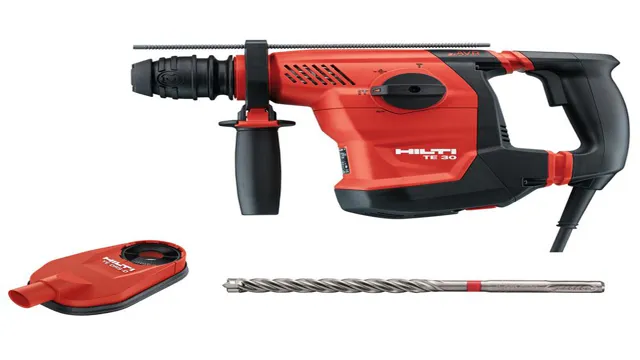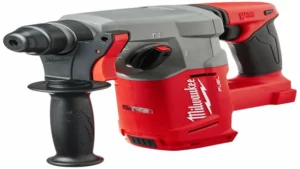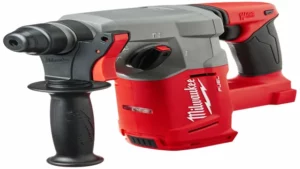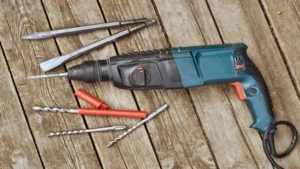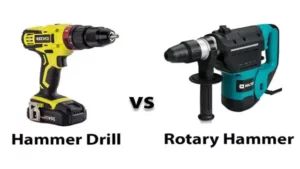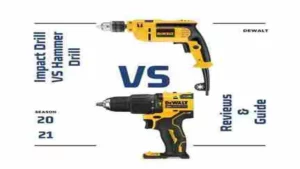If you’re planning on drilling through tough materials like concrete, you’ll need a rotary hammer drill to get the job done. But have you ever wondered how it works? Essentially, a rotary hammer drill is a more powerful version of a regular hammer drill. It uses a piston to create a much stronger hammering action.
When you turn on a rotary hammer drill, the motor drives the piston forward and back at high speeds, which creates a highly potent hammering action that’s perfect for breaking apart tough materials. In this blog post, we’ll break down the process even further and explain how all the components work together to make a rotary hammer drill an indispensable tool for construction workers, DIY enthusiasts, and anyone else who needs to drill through solid materials.
Overview of Rotary Hammer Drills
A rotary hammer drill is a powerful tool designed to bore through hard materials such as concrete and masonry. It works by combining a rotary motion with a hammering action that allows it to penetrate even the toughest surfaces. First, a motor drives the drill bit into the material, while a mechanism inside the tool accelerates the hammer up and down the length of the bit.
This motion creates a sort of chipping effect that breaks up the material, allowing the drill bit to progress further into it. The drill’s unique design allows it to apply force effectively and efficiently, making it the go-to tool for heavy-duty drilling tasks. Whether you’re a professional contractor or a DIY enthusiast, a rotary hammer drill is an essential addition to your tool collection.
Definition and Types of Rotary Hammer Drills
Rotary hammer drills are powerful tools that are designed to make drilling and chiselling easier and more efficient. They are incredibly versatile and can be used for a wide range of applications, including drilling through concrete, brick, and stone. Unlike regular drills, rotary hammer drills use a piston mechanism to deliver a powerful and consistent force to the bit, which makes drilling into hard materials much easier.
There are two main types of rotary hammer drills – the SDS-plus and the SDS-max. The SDS-plus is the smaller of the two, with a maximum capacity of around 1 inch, while the SDS-max is larger and can handle bits of up to 2 inches in diameter. Both types of rotary hammer drills are essential tools for anyone who needs to drill into hard materials regularly.
Mechanism of Action
Rotary hammer drills are powerful tools used for drilling and breaking through tough surfaces like concrete, stone, and masonry. They work on the principle of using a piston to generate high-powered impacts like a hammer while also rotating the drill bit like a regular drill. The motor powers a crankshaft that drives the piston back and forth inside a cylinder.
The piston hits a hammering mechanism that in turn transfers the energy to the drill bit via a mechanical coupling. This mechanism produces an impact that both chips away at and drills through the material. The piston’s kinetic energy is sufficient to drill into even the hardest of surfaces and break through solid concrete.
And the slotted drive rod in the mechanism helps ensure that the piston hits the drill bit in the correct position while it rotates, making it an ideal tool for heavy-duty jobs such as construction and demolition. Overall, rotary hammer drills are a powerful and indispensable tool in the arsenal of contractors, builders, and craftsmen who need to drill or demolish concrete structures.
Components of a Rotary Hammer Drill
If you’re wondering how a rotary hammer drill works, it’s all in the components. Rotary hammer drills are specialized power tools used to drill holes into concrete, masonry, and other tough materials. The first component is the motor, which turns the drill bit at high speeds.
The second is the “hammer” mechanism, which delivers a powerful pounding force to the bit, making it possible to drill through hard surfaces. This mechanism is what sets a rotary hammer drill apart from a regular hammer drill. The third is the clutch, which protects the drill and the user in case of a jammed bit.
Finally, the handle is a crucial component that ensures a firm, comfortable grip for precise drilling. All of these parts work together to provide the power and precision needed for successful drilling in tough materials. By understanding the function and importance of each component, you’ll be able to choose the right rotary hammer drill for your specific needs.
Motor
When it comes to a rotary hammer drill, the motor is undoubtedly a vital component. It’s responsible for powering the drill and giving it the ability to drill through tough surfaces. Most rotary hammers utilize an electric motor because of its efficiency and reliability.
The motor operates on a system of gears, belts, and levers that transmit power to the drill bit. The size of the motor typically determines the power output of the drill, with more powerful motors allowing for larger and more challenging drilling tasks. To enhance the lifespan and durability of the motor, proper maintenance is necessary, which includes regular cleaning, lubrication, and ensuring the motor doesn’t overheat during use.
Overall, the motor is an essential mechanism in the operation of a rotary hammer drill and requires proper care to ensure its long-lasting performance.
Piston and Hammer
A rotary hammer drill is a powerful tool that combines both rotary motion and hammering action to drill through tough materials like concrete, brick, and masonry. The piston and hammer are two integral components that work together to create the necessary impact force for the drill to operate efficiently. The piston is responsible for generating the rotational force that moves the drill bit.
The hammer, on the other hand, is responsible for providing the necessary impact force that breaks through hard materials. The piston inside a rotary hammer drill is designed to move back and forth in a circular motion, which generates torque and rotates the drill bit. The hammer, on the other hand, is designed to move up and down at a high velocity, delivering a powerful impact force that helps to break through tough materials.
These two components work in conjunction with each other to create the ideal drilling environment, making it possible to work on tough materials without excessive effort or strain. In summary, the piston and hammer are two of the most critical components of a rotary hammer drill. The piston provides rotary motion while the hammer delivers the necessary impact force for drilling through tough materials.
Understanding how these two components work together is crucial if you want to get the most out of your rotary hammer drill. So next time you’re operating this powerful tool, remember the importance of the piston and hammer!
Transmission
A rotary hammer drill is a powerful tool used for drilling through tough surfaces like concrete and masonry. Its efficiency lies in its transmission, which consists of several crucial components. One such component is the gearbox that transfers the power from the motor to the drill bit.
The gearbox also controls the speed and direction of the drill bit rotation. Another vital component is the clutch, which decouples the motor from the drill bit when the bit meets an obstacle. This prevents the motor from overheating and extends the drill’s lifespan.
The hammering mechanism is also an essential part of the transmission, responsible for the tool’s ability to drill into concrete. It compresses and releases a piston that drives the bit forward, breaking the concrete with each impact. Lastly, the transmission assembly’s housing protects the gearbox and other components from damage due to harsh working environments.
A rotary hammer drill is only as good as its transmission, and proper maintenance of these components can significantly prolong the tool’s lifespan.
Bit Holder
The bit holder is one of the essential components that makes up a rotary hammer drill. It’s the piece that keeps the drill bit in place and helps to transmit the energy from the drill’s motor to the surface being drilled. Choosing the right bit holder is important because it ensures a secure fit that minimizes slippage and improves drilling precision.
Typically, bit holders are made from high-grade steel, allowing them to withstand the intense forces experienced during drilling. Some bit holders come with a locking mechanism or collar that makes bit changes quicker and easier. Overall, the bit holder is a crucial piece of the rotary hammer drill that plays a significant role in determining the efficiency and outcome of any drilling job.
Operating a Rotary Hammer Drill
If you’re wondering how does a rotary hammer drill work, it’s important to understand that it’s a powerful tool designed to drill through tough materials like concrete, stone, and brick. Unlike a regular drill, a rotary hammer drill uses a piston mechanism to generate a forceful hammering action. When you start drilling, the piston moves back and forth rapidly, hitting a chisel or a bit attached to the end of the drill.
This action allows the drill to bore into the hard surface with ease. Additionally, rotary hammer drills also have a rotation mechanism that helps break up the material and remove debris from the hole. The combination of the hammering and rotation actions is what gives the rotary hammer drill its unique strength and speed.
It’s important to use the right bit size and type, and to apply appropriate pressure when drilling to avoid damaging the tool and to ensure precise results.
Safety Precautions
Operating a rotary hammer drill can be a daunting task, especially for beginners. Therefore, it is important to follow specific safety precautions to avoid any potential hazards. Always wear protective gear, including eye goggles, earplugs, and a dust mask to protect yourself from debris and dust.
Before using the drill, make sure the area is clear of any obstructions or people. The drill should also be properly grounded and the electrical cord should not be damaged. Additionally, never force the drill into a surface and use the appropriate drill bit size for the task.
Remember to maintain a firm grip on the drill and keep your body balanced during use. Following these simple safety precautions before and during operation can make the process much safer and more efficient for all involved.
Steps to Operate a Rotary Hammer Drill
If you’re planning to undertake a large-scale construction project or DIY task that requires piercing tough materials like concrete, bricks, or stones, a rotary hammer drill can be your best tool for the job. But before you start operating, it’s essential to keep a few critical steps in mind. First, make sure to read the manual thoroughly and understand the machine’s safety features.
Properly wear eye and ear protection, gloves, and a dust mask to keep yourself safe. Second, if the model has a chuck, select the right size of drill bit that suits the task. You can mark the drilling spot with a pencil or marker to prevent errors.
Third, hold the machine steadily with a solid grip and align the drill bit perpendicularly to the surface you’re drilling into. Use the depth gauge to measure the required depth and avoid over-drilling. Finally, position the hammer drill correctly and start drilling at a low speed, gradually increasing the pace as needed.
Remember to keep the machine clean and lubricated for its long-term use. By following these simple steps, you can safely and efficiently operate a rotary hammer drill, and accomplish your work with ease.
Conclusion
In conclusion, a rotary hammer drill is like a jackhammer and a drill had a baby. It uses a combination of hammering and drilling action to power through even the toughest materials. It’s the perfect tool for those who want to feel like they’re breaking through walls, both literally and figuratively.
So whether you’re a professional contractor or a DIY enthusiast, a rotary hammer drill is a must-have in your toolbox. As they say, when you need to get to the core of the problem, just give it a good ol’ rotary hammer drill.”
FAQs
What is a rotary hammer drill and what sets it apart from a regular drill?
A rotary hammer drill is a power tool that functions by exerting a strong pounding force while rotating at the same time. Compared to a regular drill, a rotary hammer drill delivers a more powerful impact and is typically used for heavy-duty tasks on concrete, masonry, and other tough materials.
How does a rotary hammer drill generate its impact force?
A rotary hammer drill generates its impact force through a piston mechanism that moves back and forth as the drill bit rotates. This piston strikes the back end of the drill bit, creating a powerful hammering effect that can break through hard surfaces.
What are the different types of rotary hammer drills available in the market?
The three main types of rotary hammer drills available in the market are the corded rotary hammer drill, the cordless rotary hammer drill, and the SDS rotary hammer drill. Each type has its own advantages and disadvantages based on the user’s needs and preferences.
Can a rotary hammer drill be used for other tasks besides drilling?
Yes, a rotary hammer drill can be used for other tasks besides drilling. With the right attachments, it can also be used for chiseling, scraping, and carving tasks.
How do you choose the right drill bit to use with a rotary hammer drill?
The choice of drill bit to use with a rotary hammer drill depends on the material you intend to work on. For hard materials like concrete, a carbide-tipped or diamond-tipped bit will work best, while softer materials like wood or metal require softer bits.
How do you maintain and care for a rotary hammer drill?
Proper maintenance and care for a rotary hammer drill involves keeping the tool clean, lubricated, and properly stored when not in use. Regularly cleaning the drill bit and replacing worn-out parts also helps to ensure the tool stays in good working order.
What safety precautions should you take when using a rotary hammer drill?
When using a rotary hammer drill, it is important to wear safety goggles, gloves, and earplugs to protect yourself from flying debris and loud noises. To avoid accidental electrocution, always unplug the tool before changing the drill bit or performing maintenance.
